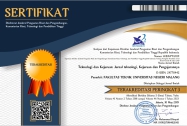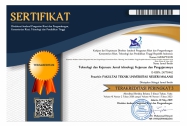Evaluation of Online Learning in Vocational High School Major in Accounting and Financial Institution: Kirkpatrick’s Model
Abstract
Keywords
Full Text:
PDFReferences
Arikunto, S. (2010). Prosedur penelitian suatu pendekatan praktik. Jakarta: Rineka Cipta.
Arikunto, S. & Cepi, S. A. J. (2009). Evaluasi Program Pendidikan: Pedoman Teoritis Praktis bagi Mahasiswa dan Pratisi. Jakarta: Bumi Aksara.
Alsalamah, A., & Callinan, C. (2021). Adaptation of Kirkpatrick’s four-level model of training criteria to evaluate training programmes for head teachers. Education Sciences, 11(3), 166.
Anis, M., & Anwar, C. (2020). Self-organized learning environment teaching strategy for ELT in Merdeka Belajar concept for high school students in Indonesia. JEES (Journal of English Educators Society), 5(2), 199–204.
Badu, S. Q. (2013). Implementasi Evaluasi Model Kirkpatrick pada Perkuliahan Masalah Nilai Awal dan Syarat Batas. Jurnal Penelitian dan Evaluasi Pendidikan, 16. 102-129. doi: 10.21831/pep.v16i0.1108.
Bari, S., Incorvia, J., Iverson, K. R., Bekele, A., Garringer, K., Ahearn, O., Drown, L., Emiru, A. A., Burssa, D., Workineh, S., Sheferaw, E. D., Meara, J. G., & Beyene, A. (2021). Surgical data strengthening in Ethiopia: results of a Kirkpatrick framework evaluation of a data quality intervention. Global Health Action, 14(1), 1855808.
Basaran, M., Dursun, B., Gur Dortok, H. D., & Yilmaz, G. (2021). Evaluation of Preschool Education Program According to CIPP Model. Pedagogical Research, 6(2), em0091.
CAHAPAY, M. (2021). Kirkpatrick Model: Its Limitations as Used in Higher Education Evaluation. International Journal of Assessment Tools in Education, 8(1), 135–144.
Hays, Lauren. 2021. The CIPP Model of Evaluation. Retrieved from https://lucidea.com/blog/the-cipp-model-of-evaluation/
Herbert, T. T. (1977). Toward an Administrative Model of the Communication ProceSP. Journal of BusineSP Communication, 14(4), 25–35. doi:10.1177/002194367701400403
Haq, A., Slamet, A., & Suminar, T. (2019). Link and Match Based Partnership Management in the Fashion Expertise Program at SMK Negeri 6 Semarang. Educational Management, 8(2), 194–200.
Kirkpatrick, D.L. & Kirkpatrick J.D. 2006. Evaluating Training Programs: The Four Levels (3rd ed.) San Francisco: Berret Kohler Publisher, Inc.
Kurt, S. "Kirkpatrick Model: Four Levels of Learning Evaluation," in Educational Technology, October 24, 2016. Retrieved from https://educationaltechnology.net/kirkpatrick-model-four-levels-learning-evaluation/
Khlaisang, J., & Songkram, N. (2019). Designing a Virtual Learning Environment System for Teaching Twenty-First Century Skills to Higher Education Students in ASEAN. Technology, Knowledge and Learning, 24(1), 41–63.
Kim, S., Raza, M., & Seidman, E. (2019). Improving 21st-century teaching skills : The key to effective 21st- century learners. Research in Comparative & International Education, 14(1), 99 –117.
Lantu, D. C., Labdhagati, H., Razanaufal, M. W., & Sumarli, F. D. (2020). Was the training effective? Evaluation of managers’ behavior after a leader development program in Indonesia’s best corporate university. International Journal of Training Research, 1–16.
León, S. P., Carcelén Fraile, M. del C., & García-Martínez, I. (2021). Development of Cognitive Abilities through the Abacus in Primary Education Students: A Randomized Controlled Clinical Trial. Education Sciences, 11(2), 83.
McDavid, J. C., Huse, I., & Hawthorn, L. R. L. (2019). Program Evaluation and Performance Measurement: An Introduction to Practice (3rd ed.). Thousand Oaks: SAGE Publications, Inc.
Meilya, R.I., & Syamsi, I. (2015). Evaluasi Program Pelatihan In-House Training Pembelajaran Paket C di Sanggar Kegiatan Belajar Jawa Tengah. Jurnal Pendidikan dan Pemberdayaan Masyarakat, 2 (2), 156–174. Retrieved from:http://journal.uny.ac.id/index.php/jppm
Masitoh, S., & Cahyani, F. (2020). Penerapan Sistem Among Dalam Proses Pendidikan Suatu Upaya Mengembangkan Kompetensi Guru. Kwangsan: Jurnal Teknologi Pendidikan, 8(1), 122. https://doi.org/10.31800/jtp.kw.v8n1.p122--141
Mohammed Benmoussa. (2020). Evaluation Of Employees Training Effectiveness In Algerian Universities Using Kirkpatrick Model: An Exploratory Study. Journal of Economics and Applied Statistics, 17(1), 6–23.
Praslova, L. (2010). Adaptation of Kirkpatrick’s four level model of training criteria to aSPeSPment of learning outcomes and program evaluation in Higher Education. Journal Education ASPesment, Evaluation and Accountability, 22(3)
Peñalba, E. H., & Clacio, D. M. (2017). Assessment of Special Provision for Empowering Diverse Pupils (SPED) Extension Service Project using Context, Input, Process, and Product Evaluation Model (CIPP) Ericson H. Peñalba & Denia M. Clacio. Faculty Journal, 6(1), 15–30.
Pilz, M., & Regel, J. (2021). Vocational Education and Training in India: Prospects and Challenges from an Outside Perspective. Margin, 15(1), 101–121.
Reese, D., Dolansky, M. A., Moore, S. M., Bolden, H., & Singh, M. K. (2021). Quality improvement education innovation: evaluation of Coursera MOOC ‘Take the Lead on Healthcare Quality Improvement.’ Journal of Research in Nursing, 26(1–2), 62–78.
Sahni, J. (2020). Managerial training effectiveness: An assessment through Kirkpatrick framework. TEM Journal, 9(3), 1227–1233.
Singh, S., Sharma, L., & Kumar, B. (2021). Machine Learning Based Predictive Model for Coronavirus Pandemic Machine Learning Based Predictive Model for Coronavirus Pandemic. Journal of Physics: Conference Series PAPER.
Sitorus, H,M., & Tania, P. (2012). Evaluasi Pelaksanaan Pelatihan Berdasarkan Konsep Kirkpatrick: Studi Kasus di PT. X Bandung. Jurnal Universitas Muhamadiyah Surakarta Retrieved from: http://publikasiilmiah.ums.ac.id
Stake, R. E. 1977. The Countenance of Educational Evaluation. In A. A. Bellack & H. M. Kliebard (Eds.), Curriculum and Evaluation, 372-390. Berkeley, CA: McCutchan.
Stark, J.S. & Thomas, A. (1994). ASPesment and Program Evaluation. Needham Height: Simon & Schuster Custom Publishing.
Stufflebeam, D. L & Zhang, G. (2017). The Cipp Evaluation Model:
Stufflebeam, D.L, 1971. Educational Evaluation and Decision Making. Itaca lllionois: FE. Peacock.
Stufflebeam, D.L. & A.J. Shinkfield. 1985. Systematic Evaluation: Self-Instructional Guide. Itaca lllionois: FE. Peacock
Terttiaavini, Marnisah, L., Yulius, Y., & Saputra, T. S. (2020). Evaluating the Kemplang Tunu Production Training for Low Income and Education Communities Using the Kirkpatrick Model. Advances in Economics, Business and Management Research, 151(1), 238–242.
Vilà-Giménez, I., & Prieto, P. (2021). The Value of Non-Referential Gestures: A Systematic Review of Their Cognitive and Linguistic Effects in Children’s Language Development. Children, 8(2), 148.
Wiratraman, H. P., & Lafrance, S. (2021). Protecting Freedom of Expression in Multicultural Societies: Comparing Constitutionalism in Indonesia and Canada. Yuridika, 36(1), 75.
Wu, X. (2021). Application of Artificial Intelligence in Modern Vocational Education Technology. Journal of Physics: Conference Series, 1881(3).
Zulkardi, Nusantara, D. S., & Putri, R. I. I. (2021). Designing PISA-like task on uncertainty and data using Covid-19 context. Journal of Physics: Conference Series, 1722(5), 1–6.
DOI: http://dx.doi.org/10.17977/um031v45i12022p66-71
Refbacks
- There are currently no refbacks.
Copyright (c) 2023 Teknologi dan Kejuruan: Jurnal Teknologi, Kejuruan, dan Pengajarannya
Teknologi dan Kejuruan: Jurnal Teknologi, Kejuruan, dan Pengajarannya
E-ISSN 2477-0442 (online)
Contact
Faculty of Engineering, Universitas Negeri Malang (UM)
Jl. Semarang No 5 Malang 65145, Building H5, 1st Floor.
Homepage: http://journal2.um.ac.id/index.php/teknologi-kejuruan
Email: teknologikejuruan.ft@um.ac.id

This work is licensed under a Creative Commons Attribution 4.0 International License.



2.png)
1.png)
1.png)
1.png)
4.png)
1.png)
.png)

3.png)
1.png)
1.png)


